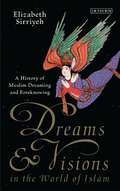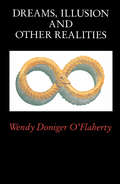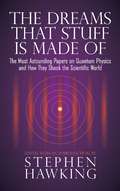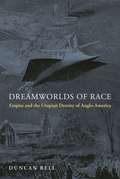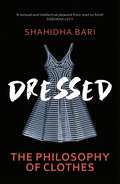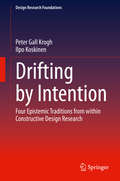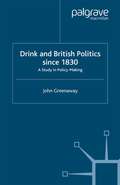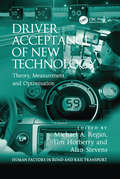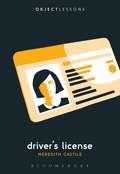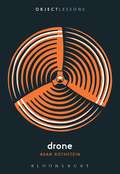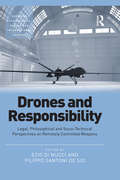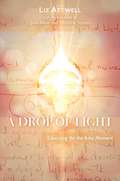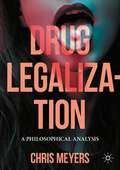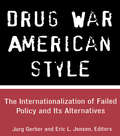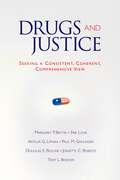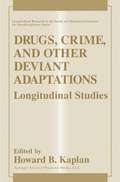- Table View
- List View
Dreams and Visions in the World of Islam: A History of Muslim Dreaming and Foreknowing (Library of Modern Religion)
by Elizabeth SirriyehPeople in Western societies have long been interested in their dreams and what they mean. However, few non-Muslims in the West are likely to seek interpretation of those dreams to help them make life-changing decisions. In the Islamic world the situation is quite different. Dreaming and the import of visions are here of enormous significance, to the degree that many Muslims believe that in their dreams they are receiving divine guidance: for example, on whether or not to accept a marriage proposal, or a new job opportunity. In her authoritative new book, Elizabeth Sirriyeh offers the first concerted history of the rise of dream interpretation in Islamic culture, from medieval times to the present. Central to the book is the figure of the Prophet Muhammad - seen to represent for Muslims the perfect dreamer, visionary and interpreter of dreams. Less benignly, dreams have been exploited in the propaganda of Islamic militants in Afghanistan, and in apocalyptic visions relating to the 9/11 attacks. This timely volume gives an important, fascinating and overlooked subject the exploration it has long deserved.
Dreams, Illusion, and Other Realities
by Wendy Doniger O'Flaherty"Wendy Doniger O'Flaherty . . . weaves a brilliant analysis of the complex role of dreams and dreaming in Indian religion, philosophy, literature, and art. . . . In her creative hands, enchanting Indian myths and stories illuminate and are illuminated by authors as different as Aeschylus, Plato, Freud, Jung, Kurl Gödel, Thomas Kuhn, Borges, Picasso, Sir Ernst Gombrich, and many others. This richly suggestive book challenges many of our fundamental assumptions about ourselves and our world."—Mark C. Taylor, New York Times Book Review "Dazzling analysis. . . . The book is firm and convincing once you appreciate its central point, which is that in traditional Hindu thought the dream isn't an accident or byway of experience, but rather the locus of epistemology. In its willful confusion of categories, its teasing readiness to blur the line between the imagined and the real, the dream actually embodies the whole problem of knowledge. . . . [O'Flaherty] wants to make your mental flesh creep, and she succeeds."—Mark Caldwell, Village Voice
Dreams, Illusion, and Other Realities
by Wendy Doniger O'Flaherty"Wendy Doniger O'Flaherty . . . weaves a brilliant analysis of the complex role of dreams and dreaming in Indian religion, philosophy, literature, and art. . . . In her creative hands, enchanting Indian myths and stories illuminate and are illuminated by authors as different as Aeschylus, Plato, Freud, Jung, Kurl Gödel, Thomas Kuhn, Borges, Picasso, Sir Ernst Gombrich, and many others. This richly suggestive book challenges many of our fundamental assumptions about ourselves and our world."—Mark C. Taylor, New York Times Book Review "Dazzling analysis. . . . The book is firm and convincing once you appreciate its central point, which is that in traditional Hindu thought the dream isn't an accident or byway of experience, but rather the locus of epistemology. In its willful confusion of categories, its teasing readiness to blur the line between the imagined and the real, the dream actually embodies the whole problem of knowledge. . . . [O'Flaherty] wants to make your mental flesh creep, and she succeeds."—Mark Caldwell, Village Voice
Dreams, Illusion, and Other Realities
by Wendy Doniger O'Flaherty"Wendy Doniger O'Flaherty . . . weaves a brilliant analysis of the complex role of dreams and dreaming in Indian religion, philosophy, literature, and art. . . . In her creative hands, enchanting Indian myths and stories illuminate and are illuminated by authors as different as Aeschylus, Plato, Freud, Jung, Kurl Gödel, Thomas Kuhn, Borges, Picasso, Sir Ernst Gombrich, and many others. This richly suggestive book challenges many of our fundamental assumptions about ourselves and our world."—Mark C. Taylor, New York Times Book Review "Dazzling analysis. . . . The book is firm and convincing once you appreciate its central point, which is that in traditional Hindu thought the dream isn't an accident or byway of experience, but rather the locus of epistemology. In its willful confusion of categories, its teasing readiness to blur the line between the imagined and the real, the dream actually embodies the whole problem of knowledge. . . . [O'Flaherty] wants to make your mental flesh creep, and she succeeds."—Mark Caldwell, Village Voice
Dreams, Illusion, and Other Realities
by Wendy Doniger O'Flaherty"Wendy Doniger O'Flaherty . . . weaves a brilliant analysis of the complex role of dreams and dreaming in Indian religion, philosophy, literature, and art. . . . In her creative hands, enchanting Indian myths and stories illuminate and are illuminated by authors as different as Aeschylus, Plato, Freud, Jung, Kurl Gödel, Thomas Kuhn, Borges, Picasso, Sir Ernst Gombrich, and many others. This richly suggestive book challenges many of our fundamental assumptions about ourselves and our world."—Mark C. Taylor, New York Times Book Review "Dazzling analysis. . . . The book is firm and convincing once you appreciate its central point, which is that in traditional Hindu thought the dream isn't an accident or byway of experience, but rather the locus of epistemology. In its willful confusion of categories, its teasing readiness to blur the line between the imagined and the real, the dream actually embodies the whole problem of knowledge. . . . [O'Flaherty] wants to make your mental flesh creep, and she succeeds."—Mark Caldwell, Village Voice
The Dreams That Stuff Is Made Of: The Most Astounding Papers of Quantum Physics--and How They Shook the Scientific World
by Stephen Hawking"God does not play dice with the universe." So said Albert Einstein in response to the first discoveries that launched quantum physics, as they suggested a random universe that seemed to violate the laws of common sense. This 20th-century scientific revolution completely shattered Newtonian laws, inciting a crisis of thought that challenged scientists to think differently about matter and subatomic particles.The Dreams That Stuff Is Made Of compiles the essential works from the scientists who sparked the paradigm shift that changed the face of physics forever, pushing our understanding of the universe on to an entirely new level of comprehension. Gathered in this anthology is the scholarship that shocked and befuddled the scientific world, including works by Niels Bohr, Max Planck, Werner Heisenberg, Max Born, Erwin Schrodinger, J. Robert Oppenheimer, Richard Feynman, as well as an introduction by today's most celebrated scientist, Stephen Hawking.
The Dreams That Stuff Is Made Of: The Most Astounding Papers of Quantum Physics--and How They Shook the Scientific World
by Stephen Hawking"God does not play dice with the universe." So said Albert Einstein in response to the first discoveries that launched quantum physics, as they suggested a random universe that seemed to violate the laws of common sense. This 20th-century scientific revolution completely shattered Newtonian laws, inciting a crisis of thought that challenged scientists to think differently about matter and subatomic particles.The Dreams That Stuff Is Made Of compiles the essential works from the scientists who sparked the paradigm shift that changed the face of physics forever, pushing our understanding of the universe on to an entirely new level of comprehension. Gathered in this anthology is the scholarship that shocked and befuddled the scientific world, including works by Niels Bohr, Max Planck, Werner Heisenberg, Max Born, Erwin Schrodinger, J. Robert Oppenheimer, Richard Feynman, as well as an introduction by today's most celebrated scientist, Stephen Hawking.
Dreamworlds of Race: Empire and the Utopian Destiny of Anglo-America
by Duncan BellHow transatlantic thinkers in the late nineteenth and early twentieth centuries promoted the unification of Britain and the United StatesBetween the late nineteenth century and the First World War an ocean-spanning network of prominent individuals advocated the unification of Britain and the United States. They dreamt of the final consolidation of the Angloworld. Scholars, journalists, politicians, businessmen, and science fiction writers invested the “Anglo-Saxons” with extraordinary power. The most ambitious hailed them as a people destined to bring peace and justice to the earth. More modest visions still imagined them as likely to shape the twentieth century. Dreamworlds of Race explores this remarkable moment in the intellectual history of racial domination, political utopianism, and world order.Focusing on a quartet of extraordinary figures—Andrew Carnegie, W. T. Stead, Cecil J. Rhodes, and H. G. Wells—Duncan Bell shows how unionists on both sides of the Atlantic reimagined citizenship, empire, patriotism, race, war, and peace in their quest to secure global supremacy. Yet even as they dreamt of an Anglo-dominated world, the unionists disagreed over the meaning of race, the legitimacy of imperialism, the nature of political belonging, and the ultimate form and purpose of unification. The racial dreamworld was an object of competing claims and fantasies. Exploring speculative fiction as well as more conventional forms of political writing, Bell reads unionist arguments as expressions of the utopianism circulating through fin-de-siècle Anglo-American culture, and juxtaposes them with pan-Africanist critiques of racial domination and late twentieth-century fictional narratives of Anglo-American empire.Tracing how intellectual elites promoted an ambitious project of political and racial unification between Britain and the United States, Dreamworlds of Race analyzes ideas of empire and world order that reverberate to this day.
Dreamworlds of Race: Empire and the Utopian Destiny of Anglo-America
by Duncan BellHow transatlantic thinkers in the late nineteenth and early twentieth centuries promoted the unification of Britain and the United StatesBetween the late nineteenth century and the First World War an ocean-spanning network of prominent individuals advocated the unification of Britain and the United States. They dreamt of the final consolidation of the Angloworld. Scholars, journalists, politicians, businessmen, and science fiction writers invested the “Anglo-Saxons” with extraordinary power. The most ambitious hailed them as a people destined to bring peace and justice to the earth. More modest visions still imagined them as likely to shape the twentieth century. Dreamworlds of Race explores this remarkable moment in the intellectual history of racial domination, political utopianism, and world order.Focusing on a quartet of extraordinary figures—Andrew Carnegie, W. T. Stead, Cecil J. Rhodes, and H. G. Wells—Duncan Bell shows how unionists on both sides of the Atlantic reimagined citizenship, empire, patriotism, race, war, and peace in their quest to secure global supremacy. Yet even as they dreamt of an Anglo-dominated world, the unionists disagreed over the meaning of race, the legitimacy of imperialism, the nature of political belonging, and the ultimate form and purpose of unification. The racial dreamworld was an object of competing claims and fantasies. Exploring speculative fiction as well as more conventional forms of political writing, Bell reads unionist arguments as expressions of the utopianism circulating through fin-de-siècle Anglo-American culture, and juxtaposes them with pan-Africanist critiques of racial domination and late twentieth-century fictional narratives of Anglo-American empire.Tracing how intellectual elites promoted an ambitious project of political and racial unification between Britain and the United States, Dreamworlds of Race analyzes ideas of empire and world order that reverberate to this day.
Dressed: The Secret Life of Clothes
by Dr Shahidha BariWe are all dressed. But how often do we pause to think about the place of our clothes in our lives? What unconscious thoughts do we express when we dress every day? Can memories, meaning and ideas be wrapped up in a winter coat?These are the questions that interest Shahidha Bari, as she explores the secret language of our clothes. Ranging freely through literature, art, film and philosophy, Dressed tracks the hidden power of clothes in our culture and our daily lives. From the depredations of violence and ageing to our longing for freedom, love and privacy, from the objectification of women to the crisis of masculinity, each garment exposes a fresh dilemma. Item by item, the story of ourselves unravels. Evocative, enlightening and dazzlingly original, Dressed is not just about clothes as objects of fashion or as a means of self-expression. This is a book about the deepest philosophical questions of who we are, how we see ourselves and how we dress to face the world.
Drifting by Intention: Four Epistemic Traditions from within Constructive Design Research (Design Research Foundations)
by Peter Gall Krogh Ilpo KoskinenConstructive design research, is an exploratory endeavor building exemplars, arguments, and evidence. In this monograph, it is shown how acts of designing builds relevance and articulates knowledge in combination. Using design acts to build new knowledge, invite reframing of questions and new perceptions to build up. Respecting the emergence of new knowledge in the process invite change of cause and action. The authors' term for this change is drifting; designers drift; and they drift intentionally, knowing what they do. The book details how drifting is a methodic practice of its own and provides examples of how and where it happens. This volume explores how to do it effectively, and how it depends on the concept of knowledge. The authors identify four epistemic traditions in constructive design research. By introducing a Knowledge/Relevance model they clarify how design experiments create knowledge and what kinds of challenges and contributions designers face when drifting. Along the lines of experimental design work the authors identify five main ways in which constructive experiments drift. Only one of them borrows its practices from experimental science, others build on precedents including arts and craft practices. As the book reveals, constructive design research builds on a rich body of research that finds its origins in some of the most important intellectual movements of 20th century. This background further expands constructive design research from a scientific model towards a more welcoming understanding of research and knowledge. This monograph provides novel actionable models for steering and navigating processes of constructive design research. It helps skill the design researcher in participating in the general language games of research and helps the design researcher build research relations beyond the discipline.
Drink and British Politics Since 1830: A Study in Policy Making
by J. GreenawayThe issue of alcohol has never been far from British politics. Initially, governments needed to control its sale for public order reasons and because it was a major source of revenue. Then in Victorian times a powerful temperance movement arose which sought to prohibit or severely curb the 'Demon Drink'. This in turn aroused the hostility of the 'Trade' and the issue became one of fierce electoral politics. After 1890 drink was interpreted more as a social reform question and then in the First World War, after a major moral panic, far-reaching measures of direct state control were imposed in the interests of national efficiency. Later in the Twentieth century alcohol use came to be seen as an aspect of leisure and town planning and, more recently, as a health issue. Drawing upon a wide range of primary sources, John Greenaway uses the complex politics of the issue to shed light upon the changing political system and to test various theories of the policymaking process. Both historians and political scientists will be interested in this study.
Driver Acceptance of New Technology: Theory, Measurement and Optimisation (Human Factors in Road and Rail Transport)
by Tim Horberry Michael A. Regan Alan StevensAcceptance of new technology and systems by drivers is an important area of concern to governments, automotive manufacturers and equipment suppliers, especially technology that has significant potential to enhance safety. To be acceptable, new technology must be useful and satisfying to use. If not, drivers will not want to have it, in which case it will never achieve the intended safety benefit. Even if they have the technology, drivers may not use it if it is deemed unacceptable, or may not use it in the manner intended by the designer. At worst, they may seek to disable it. This book brings into a single edited volume the accumulating body of thinking and research on driver and operator acceptance of new technology. Bringing together contributions from international experts from around the world, the editors have shaped a book that covers the theory behind acceptance, how it can be measured and how it can be improved. Case studies are presented that provide data on driver acceptance of a wide range of new and emerging vehicle technology. Although driver acceptance is the central focus of this book, acceptance of new technology by operators in other domains, and across cultures, is also investigated. Similarly, perspectives are derived from domains such as human computer interaction, where user acceptance has long been regarded as a key driver of product success. This book comes at a critical time in the history of the modern motor vehicle, as the number of new technologies entering the modern vehicle cockpit rapidly escalates. The goal of this book is to inspire further research and development of new vehicle technology to optimise user acceptance of it; and, in doing so, to maximise its potential to be useful, satisfying to use and able to save human life.
Driver's License (Object Lessons)
by Meredith CastileObject Lessons is a series of short, beautifully designed books about the hidden lives of ordinary things. A classic teenage fetish object, the American driver's license has long symbolized freedom and mobility in a nation whose design assumes car travel and whose vastness rivals continents. It is youth's pass to regulated vice-cigarettes, bars, tattoo parlors, casinos, strip joints, music venues, guns. In its more recent history, the license has become increasingly associated with freedom's flipside: screening. The airport's heightened security checkpoint. Controversial ID voting laws. Federally mandated, anti-terrorist driver's license re-designs. The driver's license encapsulates the contradictory values and practices of contemporary American culture-freedom and security, mobility and checkpoints, self-definition and standardization, democracy and exclusion, superficiality and intimacy, the stable self and the self in flux.Object Lessons is published in partnership with an essay series in the The Atlantic.
Driver's License (Object Lessons)
by Meredith CastileObject Lessons is a series of short, beautifully designed books about the hidden lives of ordinary things. A classic teenage fetish object, the American driver's license has long symbolized freedom and mobility in a nation whose design assumes car travel and whose vastness rivals continents. It is youth's pass to regulated vice-cigarettes, bars, tattoo parlors, casinos, strip joints, music venues, guns. In its more recent history, the license has become increasingly associated with freedom's flipside: screening. The airport's heightened security checkpoint. Controversial ID voting laws. Federally mandated, anti-terrorist driver's license re-designs. The driver's license encapsulates the contradictory values and practices of contemporary American culture-freedom and security, mobility and checkpoints, self-definition and standardization, democracy and exclusion, superficiality and intimacy, the stable self and the self in flux.Object Lessons is published in partnership with an essay series in the The Atlantic.
Drone (Object Lessons)
by Adam RothsteinObject Lessons is a series of short, beautifully designed books about the hidden lives of ordinary things. Drones are in the newspaper, on the TV screen, swarming through the networks, and soon, we're told, they'll be delivering our shopping. But what are drones? The word encompasses everything from toys to weapons. And yet, as broadly defined as they are, the word "drone†? fills many of us with a sense of technological dread. Adam Rothstein cuts through the mystery, the unknown, and the political posturing, and talks about what drones really are: what technologies are out there, and what's coming next; how drones are talked about, and how they are represented in popular culture.It turns out that drones are not as scary as they appear-but they are more complicated than you might expect. Drones reveal the strange relationships that humans are forming with their new technologies.Object Lessons is published in partnership with an essay series in the The Atlantic.
Drone (Object Lessons)
by Adam RothsteinObject Lessons is a series of short, beautifully designed books about the hidden lives of ordinary things. Drones are in the newspaper, on the TV screen, swarming through the networks, and soon, we're told, they'll be delivering our shopping. But what are drones? The word encompasses everything from toys to weapons. And yet, as broadly defined as they are, the word “drone” fills many of us with a sense of technological dread. Adam Rothstein cuts through the mystery, the unknown, and the political posturing, and talks about what drones really are: what technologies are out there, and what's coming next; how drones are talked about, and how they are represented in popular culture.It turns out that drones are not as scary as they appear-but they are more complicated than you might expect. Drones reveal the strange relationships that humans are forming with their new technologies.Object Lessons is published in partnership with an essay series in the The Atlantic.
Drones and Responsibility: Legal, Philosophical and Socio-Technical Perspectives on Remotely Controlled Weapons (Emerging Technologies, Ethics and International Affairs)
by Ezio Di Nucci Filippo Santoni SioHow does the use of military drones affect the legal, political, and moral responsibility of different actors involved in their deployment and design? This volume offers a fresh contribution to the ethics of drone warfare by providing, for the first time, a systematic interdisciplinary discussion of different responsibility issues raised by military drones. The book discusses four main sets of questions: First, from a legal point of view, we analyse the ways in which the use of drones makes the attribution of criminal responsibility to individuals for war crimes more complicated and what adjustments may be required in international criminal law and in military practices to avoid ’responsibility gaps’ in warfare. From a moral and political perspective, the volume looks at the conditions under which the use of military drones by states is impermissible, permissible, or even obligatory and what the responsibilities of a state in the use of drones towards both its citizens and potential targets are. From a socio-technical perspective, what kind of new human machine interaction might (and should) drones bring and which new kinds of shared agency and responsibility? Finally, we ask how the use of drones changes our conception of agency and responsibility. The book will be of interest to scholars and students in (military) ethics and to those in law, politics and the military involved in the design, deployment and evaluation of military drones.
Drones and Responsibility: Legal, Philosophical and Socio-Technical Perspectives on Remotely Controlled Weapons (Emerging Technologies, Ethics and International Affairs)
by Ezio Di Nucci Filippo Santoni SioHow does the use of military drones affect the legal, political, and moral responsibility of different actors involved in their deployment and design? This volume offers a fresh contribution to the ethics of drone warfare by providing, for the first time, a systematic interdisciplinary discussion of different responsibility issues raised by military drones. The book discusses four main sets of questions: First, from a legal point of view, we analyse the ways in which the use of drones makes the attribution of criminal responsibility to individuals for war crimes more complicated and what adjustments may be required in international criminal law and in military practices to avoid ’responsibility gaps’ in warfare. From a moral and political perspective, the volume looks at the conditions under which the use of military drones by states is impermissible, permissible, or even obligatory and what the responsibilities of a state in the use of drones towards both its citizens and potential targets are. From a socio-technical perspective, what kind of new human machine interaction might (and should) drones bring and which new kinds of shared agency and responsibility? Finally, we ask how the use of drones changes our conception of agency and responsibility. The book will be of interest to scholars and students in (military) ethics and to those in law, politics and the military involved in the design, deployment and evaluation of military drones.
A Drop of Light: Educating for the A-ha Moment
by Liz AttwellA-ha!Working through a topic or question, a shaft of sudden inspiration hits. The cloud of fragmented ideas and thoughts clear as a whole picture begins to form coherently in your mind. What you have now worked out – in an unexpected, exciting eureka moment – will stay with you forever. All teachers seek this experience for their students. Liz Attwell explores theories of education to argue that traditional teaching, ‘filling buckets’, must be replaced by dynamic, progressive teaching that promotes active learning – not just ‘lighting a fire’, but knowing how to lay the sticks and finding the matches too. This progressive approach seeks to create a basis for inner awakening and original insight, in order for students ultimately to come to their own a-ha moments.In A Drop of Light, Liz Attwell presents her original research into the phenomenon of a-ha moments, offering a theoretical background as well as practical advice to give teachers the tools, lesson plans, anecdotes and inspiration to bring living thinking to their own classrooms. Goethe’s approach and Rudolf Steiner’s pedagogical ideas make an important contribution, but Attwell advises that teachers following Steiner’s philosophy should enter into dialogue with educators from other backgrounds. Working together, enlightened teachers around the world can help schools and colleges to become true learning communities.
Drug Legalization: A Philosophical Analysis
by Chris MeyersThis textbook introduces students to the various arguments for and against the prohibition of recreational drugs. The arguments are carefully presented and analyzed, inviting students to consider the competing principles of liberty rights, paternalism, theories of punishment, legal moralism, and the social consequences of drug use and drug laws. Meyers extends this examination by presenting alternatives to the prohibition/legalization dichotomy, including harm reduction, decriminalization, and user licensing or on-premise use. The presentation invites readers to think clearly about the reasons and principles that should determine public policy and law, while also delving into the deeper philosophical questions underlying the drug prohibition debate. Is it morally wrong to use drugs? If so, would that be reason enough to make it illegal? Are there good reasons in favor of using illicit drugs? Do addicts lack free will, and if so, would it be unjust to punish them? What is (or ought to be) the purpose of punishment? Is the state justified in limiting the freedom of competent adults for their own good? What should be the goal of drug policy, reduced use or reduced harm?The purpose of the book is twofold. First, it is a review of the arguments for and against drug prohibition, a useful tool for policy makers, activists, and concerned citizens with an understanding of the relevant considerations for determining how we should reform our failing drug policy. Second, the book serves as a case study in the deeper issues of justice, the nature of law, rights and liberties, and the public good. Students studying applied ethics, political science, or public policy will benefit greatly from Meyers' approach.
Drug War American Style: The Internationalization of Failed Policy and its Alternatives (Current Issues in Criminal Justice)
by Jurg Gerber Eric L. JensenThis collection of scholarly essays discusses the internationalization of American drug policy from a variety of perspectives and features articles on Hong Kong, Britain, Australia, Canada, Taiwan, Latin America, the Netherlands and Switzerland.
Drug War American Style: The Internationalization of Failed Policy and its Alternatives (Current Issues in Criminal Justice #26)
by Jurg Gerber Eric L. JensenThis collection of scholarly essays discusses the internationalization of American drug policy from a variety of perspectives and features articles on Hong Kong, Britain, Australia, Canada, Taiwan, Latin America, the Netherlands and Switzerland.
Drugs and Justice: Seeking a Consistent, Coherent, Comprehensive View
by Margaret P. Battin Erik Luna Arthur G. Lipman Paul M. Gahlinger Douglas E. Rollins Jeanette C. Roberts Troy L. BooherThis compact and innovative book tackles one of the central issues in drug policy: the lack of a coherent conceptual structure for thinking about drugs. Drugs generally fall into one of seven categories: prescription, over the counter, alternative medicine, common-use drugs like alcohol, tobacco and caffeine; religious-use, sports enhancement; and of course illegal street drugs like cocaine and marijuana. Our thinking and policies varies wildly from one to the other, with inconsistencies that derive more from cultural and social values than from medical or scientific facts. Penalties exist for steroid use, while herbal remedies or cold medication are legal. Native Americans may legally use peyote, but others may not. Penalties may vary for using different forms of the same drug, such as crack vs. powder cocaine. Herbal remedies are unregulated by the FDA; but medical marijuana is illegal in most states. Battin and her contributors lay a foundation for a wiser drug policy by promoting consistency and coherency in the discussion of drug issues and by encouraging a unique dialogue across disciplines. The contributors are an interdisciplinary group of scholars mostly based at the University of Utah, and include a pharmacologist, a psychiatrist, a toxicologist, a trial court judge, a law professor, an attorney, a diatary specialist, a physician, a health expert on substance abuse, and Battin herself who is a philosopher. They consider questions like the historical development of current policy and the rationales for it; scientific views on how drugs actually cause harm; how to define the key notions of harm and addiction; and ways in which drug policy can be made more consistent. They conclude with an examination of the implications of a consistent policy for various disciplines and society generally. The book is written accessibly with little need for expert knowledge, and will appeal to a diverse audience of philosophers, bioethicists, clinicians, policy makers, law enforcement, legal scholars and practitioners, social workers, and general readers, as well as to students in areas like pharmacy, medicine, law, nursing, sociology, social work, psychology, and bioethics.
Drugs, Crime, and Other Deviant Adaptations: Longitudinal Studies (Longitudinal Research in the Social and Behavioral Sciences: An Interdisciplinary Series)
by Howard B. KaplanThis volume brings together a sample of the best of the studies that illustrate two recent trends in research on deviant behavior. The first of these trends is the investigation of deviant behavior in longitudinal perspective. Panels of subjects are followed over long periods of time to establish temporal relationships be tween deviant behavior and the antecedents and consequences of deviant behav ior. The second trend in contemporary research on deviance is the recognition of the association among forms of deviant behavior such as violence, drug abuse, and theft. The recognition of the covariation among forms of deviance stimulated questions regarding the nature of the relationships among multiple forms of de viance. Is one form of deviant behavior a cause or a consequence of other forms of deviant behavior? What variables mediate and moderate such causal relation ships? Do different forms of deviant behavior have common antecedents and consequences? Independent of the foregoing relationships, do particular forms of deviant behavior have unique antecedents and consequences? The eight original research studies that, along with the introduction and overview, constitute this volume are based on data drawn from among the most influential longitudinal studies in the general area of deviant behavior. These studies variously consider common and pattern-specific antecedents and conse quences, reciprocal influences, and intervening and moderating variables in causal relationships among drug use, crime, and other forms of deviance.
